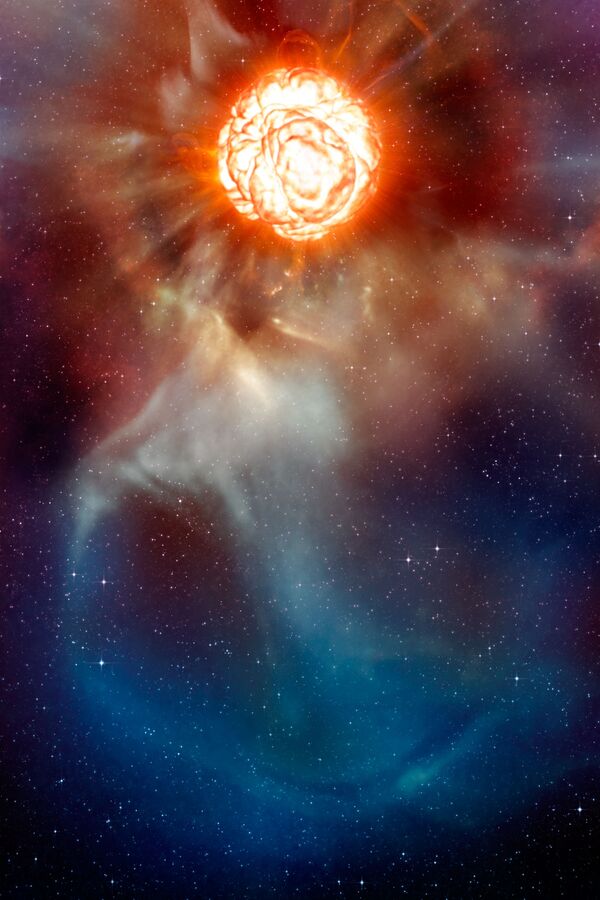The LIGO and Virgo gravitational wave detectors reported an unanticipated “burst” of gravitational waves on January 14, possibly for the first time ever, the GraceDB Gravitational-Wave Candidate Event Database has confirmed.
The event, categorized as ‘S200114f’, produced a small, barely observable ‘pop’ upon detection some hundreds of light years from Earth.
Unlike traditional gravitational waves, which can be observed upon the collision of two black holes, or the merger of neutron stars, burst gravitational waves are thought to be related to supernova events and gamma ray bursts, the latter taking place when the collision of distant neutron stars shoots beams of concentrated energy far up and away from the stars’ cores, becoming visible as “giant, brief searchlights racing away from the collision.”
Reacting to the news, excited science nerds began speculating about the source of the signal, with many wondering whether it was coming from Betelgeuse, a red supergiant star in the Orion constellation about 700 light years away which is one of the brightest visible stars in the night sky.

Users were divided about what the burst meant, with some reporting that Betelgeuse was now “visibly brighter” than Bellatrix, another bright star in the Orion constellation. Others even speculated that this means Betelgeuse may have gone supernova. “If and when it does, your evening sky is going to become very interesting for a while,” one user noted.
Just took a look outside as the clouds are clearing. Betelgeuse is visibly brighter than Bellatrix now, but has not gone supernova yet. Was that LIGO observation only “near Betelgeuse” in relative terms in its placement in our sky? Is the actual event way way further out?
— Justin Davenport (@Bubbinski) 15 января 2020 г.
The @LIGO/VIRGO has detected a burst of gravitational wave which origin is unknown. A lot of telescopes are going to observe this area of the sky to find out the source of this unusual event. #notalien #butmysterious https://t.co/EpFxDF1YN8
— Franck Marchis (@AllPlanets) 14 января 2020 г.
It's possible (though slim chance) the star Betelgeuse in the constellation of Orion may have gone Supernova. If and when it does, your evening sky is going to become very interesting for awhile.
— Daniel (@Goddy90) 14 января 2020 г.
Others let their imaginations run wild, wondering aloud whether the burst was a sign of “attack ships on fire” in a distant solar system. LIGO graciously responded, saying that scenario was “unlikely, unless they were very big and exploded,” but admitted that “we don’t have exact models for what that should look like.”
Unlikely, unless they were very big and exploded. However, we don't have exact models for what that should look like. Fortunately, we save all our data, it doesn't get lost like tears in rain, so we can check in the future if someone does the calculation
— LIGO (@LIGO) 15 января 2020 г.
Other astronomers poured cold water on the Betelgeuse supernova theory, offering a number of scientific reasons why Betelgeuse wasn’t really blowing up.
The latest @LIGO alert near Orion is NOT related to #Betelgeuse. Remember, #gravitationalwave sources are mergers (collisions) of binary stars. #Betelgeuse is still up there ... doing something ... https://t.co/NKZiLzIgid pic.twitter.com/9BlJTACSbt
— Dr. Stella Kafka (@stellakafka) 14 января 2020 г.
Because honestly Betelgeuse blowing up would be far more exciting than winning the lottery. Lottery winners happen every day. It has been 400 years since humans have seen a supernova in our galaxy, and I'm one of the best prepared people on the planet for it.
— Andy Howell (@d_a_howell) 14 января 2020 г.
Ultimately, most astronomers remain cautious, indicating that the event may even have been a false alarm, with measurement errors of this kind said to take place once every quarter century or so. In any event, although LIGO did urge caution about jumping to conclusions about the event, they also noted that what’s been discovered could be “something completely new.”
This is an unknown source type. It need not be a supernova. We could be discovering something completely new. For now, this is only a candidate. We need to do many checks to be sure we have found a signal. Please stay tuned!
— LIGO (@LIGO) 15 января 2020 г.



